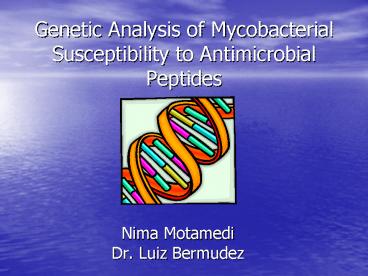Genetic Analysis of Mycobacterial Susceptibility to Antimicrobial Peptides - PowerPoint PPT Presentation
1 / 19
Title:
Genetic Analysis of Mycobacterial Susceptibility to Antimicrobial Peptides
Description:
22% of dairy cows, 8% of beef cattle are infected in the United States. ... 100 million pathogens excreted in 1 gram of infected cow dung. ... – PowerPoint PPT presentation
Number of Views:109
Avg rating:3.0/5.0
Title: Genetic Analysis of Mycobacterial Susceptibility to Antimicrobial Peptides
1
Genetic Analysis of Mycobacterial Susceptibility
to Antimicrobial Peptides
- Nima Motamedi Dr. Luiz Bermudez
2
Antimicrobial peptides
- Antimicrobial peptides are found in nearly all
organisms. - Especially common in organisms that eat from the
ground due to high bacterial content. - alpha-defensins produced in Paneth cells in small
intestine are antimicrobial peptides - Antimicrobial peptides are positively charged, so
theyre called cationic antimicrobial
peptides(CAMPS). - Attack bacterial cytoplasmic membrane which is
generally negatively charged. - CAMPs fight bacterial infections such as
Escherichia coli and other pathogens.
3
Bacterial Resistance to Antimicrobial Peptides
- To attack the cytoplasmic membrane antimicrobial
peptides modify and traverse outer membrane. - Modifications of lipopolysaccharides (LPS) in
outer membrane reduce its negative charge and
repel antimicrobial peptides.
http//www.uni-tuebingen.de/Mikrobiogen/peschel_pd
fs/AP-TIM02.pdf
4
Relevance
- Mycobacterium tuberculosis, Mycobacterium avium
and Mycobacterium avium paratuberculosis are big
threats to health and are CAMP resistant. - Mycobacterium tuberculosis causes 10 of deaths
in the 15-59 age group. - 54 million people are infected per year by
tuberculosis. - Tuberculosis is only behind AIDS in deaths from a
single infectious disease, a category that is the
largest cause of death in the world.
http//www.molbio.princeton.edu/courses/mb427/2000
/projects/0006/TBFACTS.htm
5
Relevance
- Mycobacterium avium paratuberculosis causes
Johnes disease in livestock. - 22 of dairy cows, 8 of beef cattle are infected
in the United States. - Infection caused by contaminated milk.
- Only few thousand mycobacteria required for
infection. - 100 million pathogens excreted in 1 gram of
infected cow dung. - Each diseased cow must be slaughtered and results
in loss of 245.00.
http//www.bvet.admin.ch/info-service/e/publikatio
nen/magazin/2002/3/3_24-25.pdf
6
Relevance
- Disease costs U.S. Cattle Industry 250 million
per year - Effects
- Hindered development
- Lowered milk production
- Pathogen distribution
- Hard to notice
- Symptoms develop slowly and are unspecific
- Before disease is recognized, more are usually
infected - Pasteurization doesnt fully eradicate the
mycobacteria in milk. - Connections are being made to Crohns disease
(Gastrointestinal inflammation).
http//www.bvet.admin.ch/info-service/e/publikatio
nen/magazin/2002/3/3_24-25.pdf
7
Mycobacterium smegmatis
- Good general mycobacteria model
- Genetic systems available
- Non-pathogenic
- 3-4 hour generation time
- Contains large, sequenced genome
- CAMP-resistant
8
Polymyxin B
- Produced by Bacillus Polymyxa.
- Polymyxin B serves as a surrogate for
antimicrobial peptides. - Attacks cytoplasmic membrane.
- Resistances to Polymyxin B are common.
- Cheaper and readily available.
9
Plan of Action
- Hypothesis Mycobacterium smegmatis (and other
mycobacteria) has a unique mechanism of defense
against antimicrobial peptides that involves
synthesis of proteins for their outer membrane. - Test susceptibility in Polymyxin B.
- Use transposon mutant library to identify mutants
that are more susceptible to Polymyxin B. - Test these mutants regarding survival in
macrophages.
10
What is a transposon?
- Segment of DNA that organisms readily incorporate
into their genomes. - Our transposon inserts itself randomly into the
genome. - Contains Kanamycin resistant gene.
- Transposon uptake is required for cell survival
on Kanamycin plates.
11
Characterization of Transposon Mutants
- Different clones are placed into each of the 96
wells. - Each plate is duplicated.
- Duplicate plate has Polymyxin B.
12
Plan of Action
- Determination of Polymyxin concentration required
to kill wild type cells - Determined by turbidity test.
- Lethal concentration is 64 ug/mL
full turbidity reduced turbidity - no
turbidity
13
Plan of Action
- Compare control and polymyxin libraries.
- Grow samples of susceptible mutant strains.
- Wild type dies at 64 µg/mL.
- 45 mutants from 25 plates susceptible at 1/2 of
wild-type (die at 32 µg/mL). - Four mutants susceptible at 16 µg/mL.
16
32
16
32
14
Plan of Action
- Lyse cells, purify DNA
- General PCR primed from common sequence
- Specific PCR to amplify transposon sequence
- Gel electrophoresis Plasmid excision/purificatio
n.
15
Plan of Action
- Transformation and digestion of insert.
- Gel electrophoresis sequencing.
- Compare interrupted genes with virulent bacterial
genomes in a database.
16
Interrupted Genes
- DnaB
- Involved in helical structure of DNA
- LeuS
- Also known as leucyl tRNA synthetase
- Required for addition of leucine in protein
synthesis - Both genes, if interrupted, would inhibit growth
regardless of antibiotics.
17
Interrupted Genes
- KasB
- Beta-ketoacyl-ACP synthase.
- Involved in meromycolate extension and lipid
biosynthesis. - Meromycolate is the precursor to mycolic acid.
- Mycolic acid is specific to mycobacteria and
plays a role in envelope permeability. - Tests with mycolic acid deficient Mycobacterium
tuberculosis in mice have shown a successful
immune response.
18
Down the Road
- Testing with other anti-microbial peptide
surrogates - In vitro macrophage infection with wild-type
versus mutant strains. - Testing more virulent mycobacteria Mycobacterium
tuberculosis, Mycobacterium avium, Mycobacterium
avium paratuberculosis.
19
Acknowledgements
- Howard Hughes Medical Institute
- Kevin Ahern
- Luiz Bermudez vet science laboratory staff































